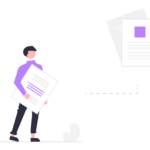Creating a customer journey map is like being a detective investigating a case. You gather clues, check multiple sources, and piece together the findings to identify where your audience is coming from, what they want, and how they make decisions. But things aren’t over once the case is closed. It's time to take action, put a killer strategy in place, and turn those customers into loyal advocates for your brand. This is where the creation of actionable customer journey maps comes into play.
Debbie Levitt, CXO of Delta CX, shared her shortcuts to building actionable journey maps at our recent event. You can find those in this article or just watch the event’s recording. Or do both. You can do anything in this world.
A little disclaimer from Debbie:
“I tend to say CX and UX interchangeably. I don't want to die on the hill of who's a customer, who's a user, who's a human, who's a dog, who's a primary customer, who's a secondary customer. So I'm just going to say customer, but it could be anybody.”
We can’t agree more. Experience is, well, experience, while the customer is the audience whose journey you are mapping.
The recording
Not a big fan of text? We’re presenting to you the incredible event recording featuring Debbie, where she spills all the beans and then some:
Still willing to dive into the sea of letters? Let’s go then.
Contents
- 1 The recording
- 2 The illusion of expertise
- 3 Key criteria for a successful journey map
- 4 Check yourself
- 5 So how do we make actionable customer journey maps?
- 6 Questions and answers as a wrapping up
- 6.1 What about the future state map for an onboarding journey that doesn't exist now?
- 6.2 What are some questions you ask in qualitative interviews to create better journey maps and heat all necessary pain points?
- 6.3 When should we do the quadrant exercise for research planning?
- 6.4 How do we know when the complexity of actionable customer journey maps is becoming too much and not useful?
The illusion of expertise
What do you need to create actionable customer journey maps?
Most would name a slick template, a mapping tool mastery, and relevant customer knowledge. And many would end up with a poor or incorrect artifact that provides them with wrong outcomes.
Let’s face it, pretty artifacts and fancy tools don't define our skills. Actionable customer journey maps come from qualitative research backed up by problem-solving, critical thinking, and asking the right questions. We need to aim for quality over quantity, not just getting the work done but getting it done right.
And while interviews can be helpful, observing the journey is best. People sometimes don't remember things or describe them inaccurately. So creating an actionable customer journey map is like being a detective. You need to choose the right people, ask the right questions, and observe everything. Then you bring it all together to report on insights and opportunities. But, yet again, it all depends on how well you research and apply journey mapping’s best practices. Your customer intelligence is only as good as your skills.
Anyone can make a journey map, just like anyone can make a sandwich. But like a sandwich, the quality depends on what you put in it. So are you setting your team up for success with excellent research and planning? Or are you just guessing? The choice is yours.
But guessing means waste. Luckily, as CX and UX professionals, we're like risk managers, saving our teams from costly mistakes and bad ideas. Our job is to attract and keep happy customers; every company wants that. By providing intelligence, we help make better decisions and achieve those goals. Journey maps are one of the tools under our belt to share that intelligence.
Why make a journey map at all? To see how our audience experiences something. Simple as that. With actionable customer journey maps, we can make decisions, prioritize, and understand our customers better. It's like a roadmap to success. We can streamline and optimize the experience to create a journey map to the future our company wants.
On the other hand, bad journey maps are a disaster. In the best-case scenario, those are doomed to be hidden away. In a worst-case scenario where we use them to strategize, they are like false prophets, leading us astray with misguided assumptions and guesses. A bad journey map is a ticking time bomb of project and company risk.
Look at this one. How do you like it?
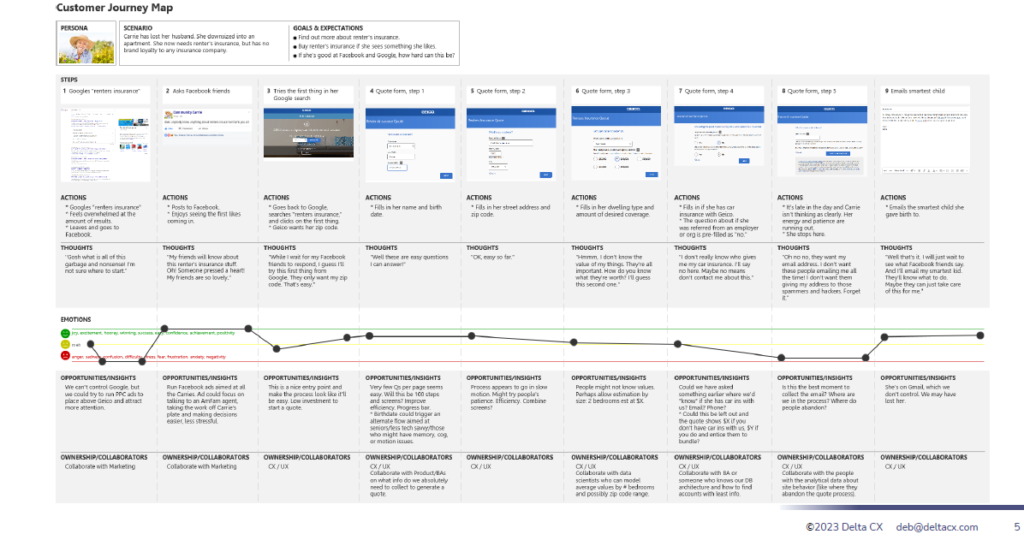
It actually looks good. But being good is not the same as being legit. The map seems thorough and organized, but what it's about is as real as a unicorn. The map was created as part of a job interview challenge for a made-up persona and a completely fabricated journey.
Creating such maps is like building a sandcastle and pretending it's a real house. But to base our business decisions on this imaginary journey, we must be living in a fairy tale. So always stick to the facts and base our journey maps on actual research, not just wishful thinking.
Key criteria for a successful journey map
Keep these criteria in mind, as they can make or break your mapping initiative:
Customer’s perspective
When it comes to journey mapping, it's all about perspective. Do we create the map from our customers' point of view, or did we map the customer journey based on how the business perceives it, such as a funnel or "awareness to advocacy?" Whose problems do we try to solve?
When suggesting solutions, we need to ask ourselves: are we solving actual problems or just playing a game of business chess with our customers as the pawns? Did we capture the journey accurately or leave out essential steps? And where did we get our information from — did we observe our customers in action, or are we just making educated guesses?
Knowledge source
If we want to create actionable customer journey maps that truly represents our customers' experiences, we can't just guess. Instead, we need to watch our customers in action, in their natural habitats. It's like studying astronomy — you can't just read about the stars in a book. So recruit the right research participants, observe them carefully, and ensure our map is based on real-life experiences.
Don't worry, we can still make guesses as long as we mark them as risks and have the plan to replace them with actual knowledge. It's like putting a caution sign on a slippery floor to warn ourselves of potential danger. A map full of assumptions can inspire us to invest in real customer research, understand our customers' real problems and pain points, and dig deeper to get to the root causes.
Problems
If we don't understand the user's real problems, it's like trying to find a needle in a haystack instead of actionable strategic work. The journey map must not be there to showcase the solutions we were hoping to build anyway. It needs to provide better decisions about our products and services.
Prioritizing
Customer intelligence put into the map also helps prioritize our work effectively. Which features do we build first? Which problems do we address first? What steps should we take next?
Inspiration for designers
A good journey map should be like a treasure map that inspires CX and UX designers to find the treasure of customer satisfaction. It should help them understand the twists and turns of the customer's journey and reveal the pain points and problems that need to be solved.
There can be more criteria, of course. Details, for instance. How much info is too much? Should we include how long each step takes? How detailed should the map be? What about variations in the journey? Not every customer will take the same path, so how do we capture that? Can we really know how people feel, or are we just guessing? Should the map only show happy endings, or can a disaster be the option?
The key is to include enough detail to write better problem statements and find opportunities for improvement and innovation.
Our map should also be thorough and uncover the truth, even if it's not pretty. Because in the end, it's not just about showing smiling faces and dancing dogs — it's about strategizing, prioritizing, and finding working customer-centric solutions to real problems.
Check yourself
Is it one of actionable customer journey maps? Use your best judgment and wit, then compare your opinion to the video answer. Game on!
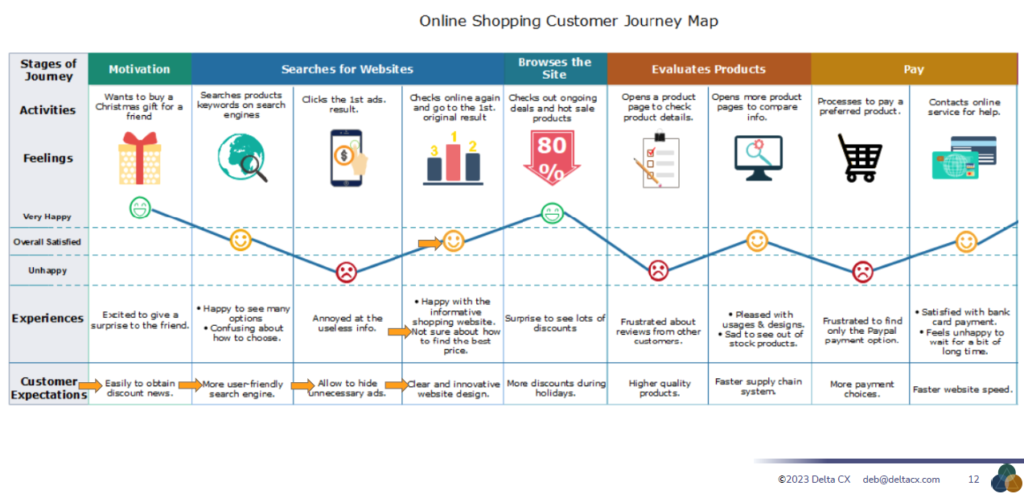
The answer is here:
Want to dive deeper and flex those CX muscles? The recording at the article’s end has even more maps to assess.
So how do we make actionable customer journey maps?
By doing research, of course!

Sometimes we create maps based on what we want or hope people will do rather than what they actually do, hoping to get permission to do what we will do anyway. But we must remember that journey mapping is more than just making things up. It requires gathering accurate information and understanding the customer's actual experience.
“An American government agency emailed me to ask about taking my customer centricity training. I sent them the webpage describing the workshop and the key takeaways, and they replied they were not interested in that workshop because they just wanted to know how to make a customer journey map.” - Debbie Levitt
Assuming is risky business, but if you need to capture your team’s or stakeholders’ assumptions, there are better ways than spending weeks on a journey mapping.
For instance, gather your team and get ready for some sticky note action.
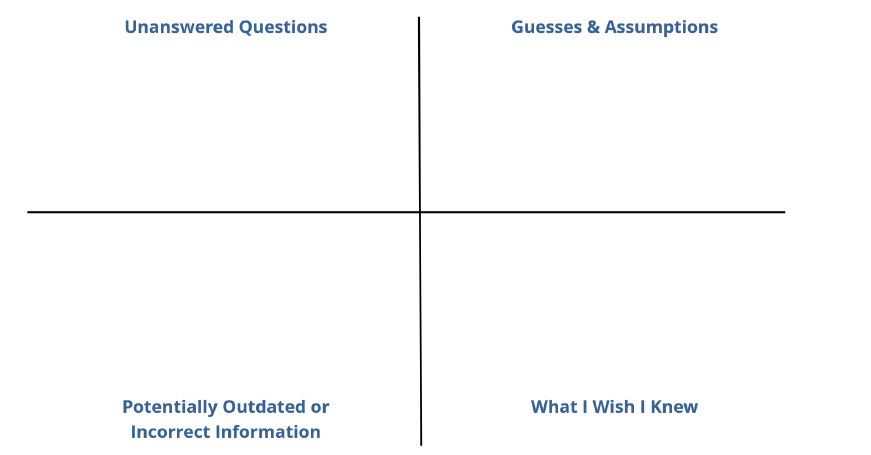
The quadrant above is a simple tool for synchronous and asynchronous meetings, workshops, or even solo brainstorming. Your mission, should you accept it, is to jot down everything you know about users, customers, tasks, journeys, and context. Remember to highlight any unanswered questions, assumptions, outdated info, or things you wish you knew.
Mixing up your questioning style will unleash a flood of ideas and get your team thinking outside the box. Plus, it's a great way to remind everyone about the risks of moving forward with a project without considering all the angles and doing proper customer intelligence.
Once you fill in the quadrant, let your qualified researchers create their goals and plan studies to answer the questions your team came up with. And remember about variations in how people do things. To consider such a thing, you may empower yourself with task analysis.
Task analysis
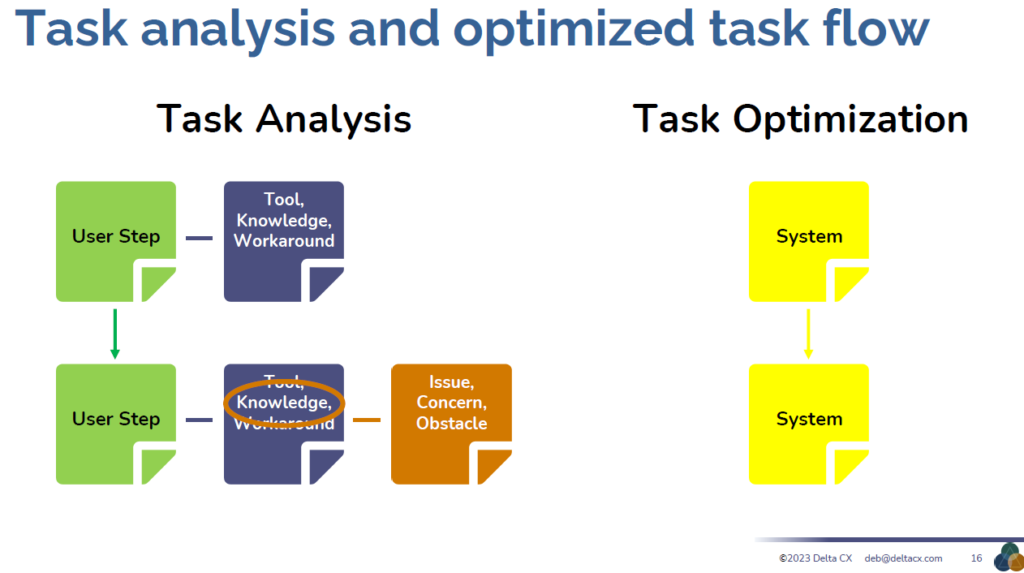
Task analysis is normally done after qualitative research, like observing and interviewing users. You can't do successful task analysis based on surveys or what we guess about people. Even diary studies can leave out steps or workarounds the user didn't mention, as they seemed unimportant. By observing these people, we can catch essential details that might be missed otherwise.
Task analysis involves observing and documenting every step a user takes to complete a task. It includes noting the tools, knowledge, and workarounds they use and any issues or concerns they encounter. By examining these factors, we can identify behaviors, themes, preferences, unmet needs, insights, and opportunities for improvement. Ultimately, task analysis helps us understand how users interact with a process and how we can make it more efficient and effective.
When conducting this kind of research, look for knowledge gaps where people may not know or understand something that we assume they do. It is especially evident in areas like airport security, where there are often misconceptions.
Observing people's workarounds can also reveal knowledge gaps like it was in a research Debbie's agency carried out in 2021. They did an observation where people pretended to shop for an item with a budget of $1,000 and needed to buy 125 items. Most people used a calculator to divide $1,000 by 125 and got $8 per item. But when the task was done, they went over budget. Only one person realized there would be additional fees and taxes, so they assumed they only had $6 per item. See? Not only did people use calculators, but only one person had the knowledge to consider additional costs.
After analyzing the task, the next step is to create an optimized task flow for the desired future state. It involves identifying areas where the system can reduce the workload for the user, like automating specific steps in the task and designing the system to account for the user's knowledge and memory. The goal is to simplify the process and make it easier for the user to complete the task.
Back to Debbie's example, they added a feature that allowed customers to enter their budget on the product page. The system would then deduct taxes, shipping fees, and other costs to show how many products they could afford. It even adjusted as they changed color or shipping speed. This feature was unique and brought a competitive advantage because, at that time, no competitor had such a solution. Thus, this technique proved to be more effective than surveys and AB tests.
If a task or flow has many steps or requires a lot of manual work, it can cause a high cognitive load for users. People generally prefer to avoid figuring things out or making sense of a confusing process, which can lead to errors. If a step in the process is particularly prone to mistakes, simply giving users an error message may not be enough to solve the problem. Moreover, It's just a bandaid on a problem without solving it.
A great customer experience prevents mistakes by ensuring users have the necessary knowledge. Sometimes we assume users know or remember something, but they don't. Let's take paying a bill online as an example. If the website asks for an account number, users may need to dig up an old bill to find it. It is an example of a knowledge-dependent customer experience. And task analysis diagrams help understand how different people may approach a task.
Or imagine you're at an airport gate, waiting for your flight. Suddenly, the announcement comes that there won't be enough space to store everyone's bags in the overhead compartments. You'll have to gate check your bag. How would you react?
Different people will react differently. Some may accept the situation and gate check their bags. Others may try to rearrange their bags or argue with the airport staff. But all of these reactions require different knowledge.
For example, some people don't know what items to remove or include when forced to gate check their bags. So there may be questions and concerns, such as when they'll receive their bags back. And if someone has an e-cigarette, they may not know that they can't put it in the cargo hold.
By observing people's reactions in this situation and mapping it out, we can better understand their questions, concerns, and knowledge gaps.
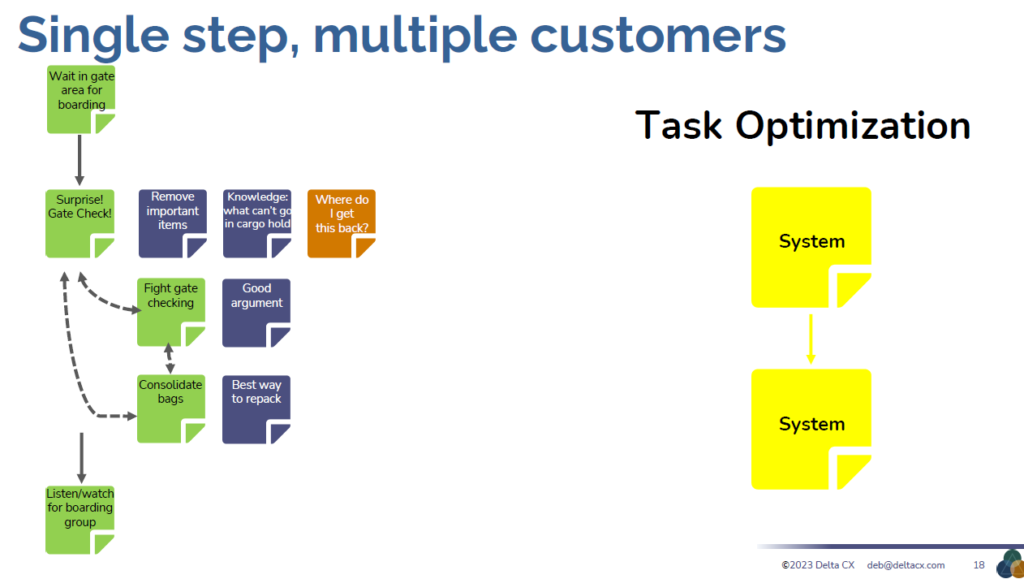
This approach is not about emotions. It's all about the specifics of the job. It's straightforward and focused on the details. For those of us who are good at finding problems and solving them, we can easily see where to make improvements. It is where we jump in and streamline the task flow.
Service blueprint for going wider
This is a type of map that Debbie made up and is still experimenting with. She calls it an expanded service blueprint, which builds on the concept of a service blueprint and takes a journey map to the next level.
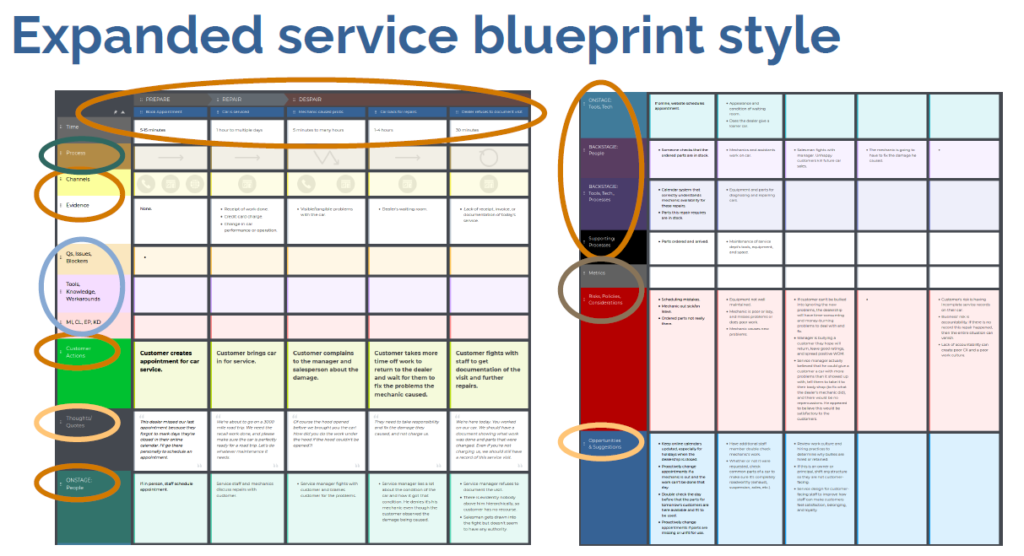
Start with the journey map, then add details about the company's operations, technology, and the people involved both on- and off-stage.
“I left off the usual swim lane for emotions. You can add that in if it's meaningful. I tend to be more focused on the experience, knowing that a better experience makes people happier.“ - Debbie Levitt
Then spice the result up with questions, issues, blockers, tools, knowledge workarounds, and these things from task dimensions, manually intensive, cognitive load, error-prone or knowledge dependent from task analysis. Use the opportunities and suggestions section not as exact solutions but as possible directions for improvement. And feel free to experiment with the content. The only rule is tending to facts. Even quotes should be authentic to the last dot.
Disaster journey map
Debbie's invention called a customer disaster journey map is the third way to level up your journey map. This map helps identify potential risks and adverse outcomes others might not see. It's helpful for complicated projects where we assume everything will go right and numerous steps are involved.
Debbie once worked on a project where a company sent customers a beauty box with small makeup samples, hoping they would purchase the full-size products online. However, the engineer and product manager didn't want to code the page so that when someone clicked the product link from the beauty box page, it showed the correct color sent in the box. As a result, Debbie had to map out a highly potential journey that the company's clients would otherwise have.
Here's a storyboard of a customer's disastrous journey:

To make it short, the journey stages looked like that:
- Getting a lipstick sample;
- Trying the product;
- Ordering its full-size version but not realizing that you ordered a different color than the sample;
- Receiving the “wrong” color;
- Reaching out to customer support;
- Freaking out on social media;
- Canceling the beauty box subscription.
Sharing this journey with the team, Debbie made them realize the risk and code the page accordingly.
Questions and answers as a wrapping up
What about the future state map for an onboarding journey that doesn't exist now?
It's surprising how much attention people give to onboarding, but not to the rest of the product. Onboarding is essential, but the advice is to keep it minimal. If your product is easy to use and understand, you don't need all those tutorials and first-time experiences. Don't overcomplicate onboarding — focus on the essentials customers need to get started.
What are some questions you ask in qualitative interviews to create better journey maps and heat all necessary pain points?
Don't ask whether your customers liked something or if they would pay for it. Instead, ask "show me how you do this" and "how could this be improved?"
And remember that qualitative observational research is way better than asking questions. Watch and study people over some time. If the study requires more than just observation, you might also use methods like diary studies or interviews.
When should we do the quadrant exercise for research planning?
It would be great to do this exercise at the beginning of every project, during the planning phase. Get your team, examine all the questions you have, and consider adding one or more research methods to answer them.
Also, the quadrant exercise is not limited to project planning. For example, a private company that does CRO and A/B testing could use it when an A/B test fails, and they don't know why the test failed or B was worse than A. It's always useful for people to take 15-20 minutes to reflect on what they know, their assumptions, what they wish to know, and what's happening. This can help you get buy-in for qualitative research that will answer our questions.
How do we know when the complexity of actionable customer journey maps is becoming too much and not useful?
Usually, the problem isn't too much complexity but a lack of information and depth of the journey. So adding more detail is fine. For instance, UXPressia allows you to navigate complex journey maps by hiding certain swimlanes for specific audiences.
We know curious minds want to know more, and our recording is just the ticket, as there are all the details and the rest of the event attendees' questions.


